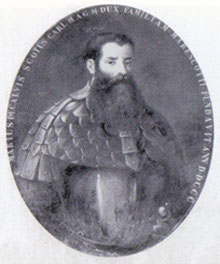|
| |
Marius Douglas
|
|
This page is a stub.
You can help improve it.
 The
family still conserves a very ancient portrait of a soldier with the
following encryption in Latin: "Marius de Calveis, Scotus, Carl Mag M
Dux Familiam Marescotti Fundavit ANN D. DCCC" (Marius of Galloway,
Scottish, military commander under Charlemagne, founder of the
Marescotti family. AD 800) The
family still conserves a very ancient portrait of a soldier with the
following encryption in Latin: "Marius de Calveis, Scotus, Carl Mag M
Dux Familiam Marescotti Fundavit ANN D. DCCC" (Marius of Galloway,
Scottish, military commander under Charlemagne, founder of the
Marescotti family. AD 800)
According to the legend, Marescotti's(1) origins date back to Mario Scoto (Marius Scotus) born in Galloway in the southwest of Scotland in
the eighth century.
In the year 773 King Charlemagne began a
military campaign against the Longobards in Italy, because he did not
respect the covenant, imposed on them by Pepin the Short, to surrender
part of their territory to the states of the church. He asked for help
from the king of Dalriada (Western Scotland) Eochaid IV.
He
commissioned his cousin(2) Count William Douglas to recruit and lead a
brigade of 4000 men in France, what he did. But later, having to return
to Galloway to rule the family clan, he left the brigade to be command
by his younger brother, Marius, whom the contemporaries called
courageous, high, strong and reddish beard.
Georgina
Gordon-Ham, reviewing a book by Prince Maurizio Ferrante Gonzaga, states:
William Douglas was a Scottish adventurer (son of
Sholto Douglas (3)), who came to Piacenza
between 775 and 787 AD with 4,000 soldiers to support the Holy Roman
Empire and help Charlemagne fight against the Lombards. William remained
in Piacenza due to bad health and married a daughter of Antonio Spettino.
They had many children and were commonly known as ‘gli Scotti’, the
children of the Scottish father. Over time the surnames Scotta and
Scotti became official. The narrative is based on detailed research
through family and historical documentation found in the State Archives
of Piacenza and Modena, in parish registers, in documents of the Scotti
and Gonzaga families.

Painting by Giuseppe Antonio Caccioli (1672 - 1740) representing Mario
Scoto and Pope Leo III
In the spring of 774, during his
subjugation of Italy, king Charlemagne and Pope Adrian I decided to
meet. With a small escort, amongst whom Mario Scoto was present,
Charlemagne travelled the ancient via Cassia to Saint Peter's Basilica
where he was received and blessed by the pope. Mario Scoto was Catholic
as were the majority of Scotsmen at the time and at the service of his
king became himself a defender of the Faith. He became an appreciated
military advisor and distinguished himself in the Spanish campaign and
in the battle against the Saxons at the confluence of the Weser with the
Aller in which of the 5,000 Saxons, only the 500 who chose to be
baptised were spared their lives.
Towards the end of the century
Mario Scoto retired from the army, married an Italian noblewoman called
Marozia and, for his devotion to the pope, settled in Rome where he was
granted the honor to escort the pope. He was therefore present when in
April 799 Pope Leo III was assaulted and kidnapped near the church of
San Lorenzo in Lucina. Mario Scoto was able to find the pope in a
monastery on the Aventine Hill and rescued him and returned him to his
throne at the Holy See. The scene was later painted in Bologna by
Giuseppe Antonio Caccioli.
Notes:
1. Marescotti was
an ancient Bolognese family of Ghibelline faith, with branches in Siena,
Rome, Florence and France.
2. Different sources
quote different relationships - son and cousin.
3.
Some say son of Hugh and grandson of Sholto.
See also:
• The Marescotti origins
• Douglas Scotti
di Vigoleno
• Scotti Douglas
• Italian members of the Douglas
family
|
Sources
Sources for this article include:
• Galeazzo Ruspoli, I Ruspoli,
Gremese Editore
Any contributions will be
gratefully accepted
|
|


